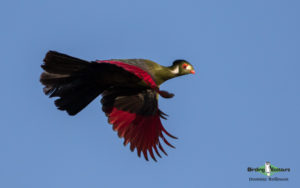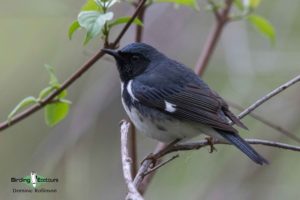Go to All Blogs | Birding Blogs | Bird Tour Preparation Blogs | All our birding tours
By Chris Lotz
My first birding trip to South America was, strangely, a great disappointment. I opted to make Peru my first South American birding experience. Peru is definitely one of the world’s richest countries for birds, boasting almost 1,800 species, following closely behind Colombia (which has the world’s highest bird species count). As I boarded the flight from Denver, Colorado, to Lima, Peru, I was over-confident, thinking I could learn “on the ground”. But when I actually arrived in the world’s most bird-rich biome, the sprawling Amazon basin in south-eastern Peru, I was in for a rude awakening. There were just too many species.
I had no idea what any of the singing birds were (I did not even yet know what a Screaming Piha sounded like – this bird gives us one of the most characteristic sounds of the Amazon). And even when I got visuals of the Peruvian birds I had to look through the biggest field guide I had ever laid hands on and go through more pages than I had ever become accustomed to. I tried hard to memorize as many of the patterns of the brightly colored tanagers and other dazzling birds that came into binocular view at high speed one after the other in mixed species flocks, then had to look them all up. I missed more than half of them as I paged through my bulky field guide. And then remembering the bird names was also a problem. If you see 15 species that you have not pre-studied, all in the space of 15 minutes, you will forget their names unless you’ve done some homework. These Peruvian mixed flocks (or “bird parties” as we call them in Africa) can really overwhelm even the most energetic birder – if not well-enough prepared! Warning!
So instead of being a wonderful experience my first ever South American birding trip was, surprisingly, frustrating. Therefore I made a pact with myself that before visiting another completely new destination I’d spend months studying beforehand. My next absolutely new birding experience was to be Bhutan, the first country in Asia that I ever birded, and the experience was quite the opposite – very rewarding, to say the least. Every bird that I lifted my binoculars to I could identify without even looking in the field guide! I was offered an immediate trip to Bhutan, but I actually refused, telling the folk who invited me that I needed at least six months to study. And what a fabulously enjoyable six months that was, getting to grips with all the unfamiliar bird families a new continent throws at you! However, I failed to master the bird calls, so I still did not know most of the species singing, unseen deep within the endless unspoiled forests of this beautiful little Himalayan country.
A few trips later, after several trial and error attempts to improve also on the bird sound aspect, personal success was finally achieved. Last September I headed back to the one of the most bird-diverse corners of our wonderful planet, Honduras, and found that I could identify almost all the species both by sight and by sound, without help from any local guide. Nothing is as satisfying as that, to me personally at least. It was good to finally feel that I had the upper hand over the Neotropics, especially after that less successful first Peru birding experience.
The purpose of this blog article is to share with you my personal approach I now use to ensure that I always maximize the enjoyment of a birding trip when the time finally arrives to board the flight and head to the new country. Here’s the list of tips, but please can you kindly write to us and add your own recommendations or suggested adjustments to the way I do this – I’m not writing as an expert, but only as someone who has been forced to learn some techniques for studying, so that I can enjoy my bird trips more and get more out of them (and of course to eventually be able to guide birding tours to the countries in question). Some of these “tips” might be considered obvious, but especially in retrospect!
When visiting a new continent, unless you have an exceptional memory and you’re a fast learner, consider FIRST going to a more temperate, less speciose part of the continent to learn a smaller number of new families and species (e.g. Bhutan, which has a rich assemblage of exciting Oriental bird families yet is less overwhelming from a sheer-numbers point of view than the lowland-rainforest-covered countries of south-east Asia such as Thailand or Malaysia). Since I studied hard for Bhutan I learned a lot more on the ground (cementing my studies further) when I finally arrived in and birded the country than I would have if I had not studied for six months beforehand. Then, when I birded the Malay Peninsula at a later date, I already knew a lot of the widespread Asian bird species (from Bhutan), and I had a good feel for the Oriental bird families in general.
So adding the new layer of birding knowledge I needed for my inaugural tropical south-east Asian birding tour was now not very difficult. The above concept can be applied slightly differently but equally effectively by choosing a bite-sized country rather than a large country when doing your first trip to a new continent. Costa Rica or Trinidad are good examples of nice little countries that make better “introductions” to the Neotropical birding experience. Costa Rica is, per unit area, virtually as rich as any of the tropical areas within South or Central America. But the advantage is that it contains only 850 bird species, compared to Colombia’s 1,850 (very roughly). That’s 1,000 fewer species to study before your trip, but not because Costa Rica is less bird-diverse (per unit area) – only because it’s so tiny a country! After one or two visits to the continent in question you’ll of course be able to master the biggest and most tropical (and hence species-rich) nations more easily.

But you may still wish to study hard, of course, to have a good feel for all the birds you encounter, even on a short introductory bird tour, and I personally use the next few steps to help me with this:
- I give myself at least a few months for studying before I fly to a new continent to start a birding tour. Time for study is of the essence.
- I purchase the field guide for the region as fast as possible after deciding on the destination. The blogs at “Recommended Bird Field Guides” tells you which field guide to use for each and every country on Planet Earth.
- I get the bird list for the country (or the part thereof that I am going to be visiting) from Avibase (but if you’re joining a tour with a bird tour company then it’s easier to ask them for the list). I then circle in pencil each species I might see in my new field guide.
- I usually then go slowly and systematically through the circled birds in the book a couple of times. I personally find that one of the most important first steps is to get the bird names to stick in my memory. And, of course, how to distinguish them from similar species – one has to try and get that to stick!
- I also purchase the app with bird sounds for the country, or if that is not available I download each and every bird sound from xeno-canto.org. Some of the best apps for the different parts of the world are mentioned at “Recommended Bird Field Guides“. Going systematically through the field guide I look at the pictures once again while also listening to the songs and calls of each species. One of the best ways of remembering bird calls is to try and think what species in your home country it sounds like. For example, I committing one of the call variations of Common Reed Bunting to my memory before my first proper Middle Eastern birding trip (which happened to be to Israel) by making a mental note that it sounded exactly like the southern African subspecies of Long-billed Pipit (the call of which I know very well – by the way, these pipits sound completely and utterly different in Israel compared to what they sound like in South Africa, and perhaps they will be split in the future!).
- I also Google a photo of each and every species circled in my field guide. This gives a much better feel for what the bird really looks like – paintings are a little abstract and unreal. Studying photos helps one to register faster what the species actually is when one raises one’s binoculars to it after eventually arriving in the country. Even a quite-easy-to-ID bird, such as my first Black-throated Blue Warbler (which was in New Jersey), stumped me for a few seconds until my brain registered. If I had studied photos it would surely have “clicked” faster.
I hope you that have enjoyed this article describing my personal technique, which improves each time I visit a new birding country. Importantly, I would like to hear from you – please share your own tips. I bet that there are a great many birders out there who manage to study a lot more efficiently than I!
 When I saw my first Black-throated Blue Warbler it was from the bottom (I was looking up, getting “warbler neck”), and I could not place it for a few seconds, until suddenly the penny dropped. This all happened in a friend’s garden in New Jersey when I first experienced the wonderful spring warbler migration of the eastern United States.
When I saw my first Black-throated Blue Warbler it was from the bottom (I was looking up, getting “warbler neck”), and I could not place it for a few seconds, until suddenly the penny dropped. This all happened in a friend’s garden in New Jersey when I first experienced the wonderful spring warbler migration of the eastern United States.
